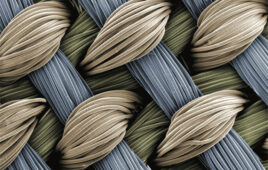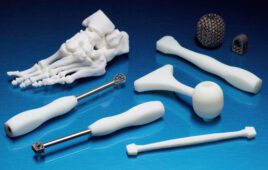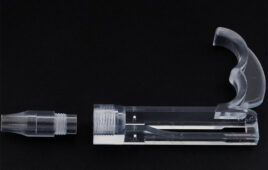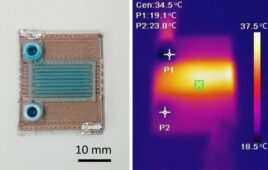3D printing and injection molding each have their own benefits and limitations when it comes to making medical device parts, according to experts from PTI Engineered Plastics, Carbon and Protolabs.

3D-printed Tyrannosaurus rex models, made with Carbon’s proprietary CLIP technology. [Image courtesy of Carbon]
Whether a manufacturer uses 3D printing or injection molding is completely reliant on what a customer’s needs are, the experts from PTI Engineered Plastics, Carbon and Protolabs explained during their March 8 panel.
In fact, the two processes may be more of a dynamic duo.
One of the advantages of 3D printing is that a manufacturer can get their hands on a product quicker than they would be able to with injection molding, while having the ability to completely customize the product. In contrast, injection molding allows parts to be produced in mass volumes.
“3D printing allows you to get parts in your hands very quickly without an investment in your tooling and it allows you to also [make] some parts that may not be necessarily designed for injection molding, but allows you to do geometries that are unique,” said John Budreau, director of new business at PTI Engineered Plastics.
“I think it’s great when it’s not a part that’s actually injection moldable,” Budreau said of 3D printing. He added that it can be costly to buy a mold upfront for a part design that is unique and complex, whether it is a personalized orthopedic device part or something else.
Budreau and others on the panel listed three limitations that are presently holding 3D printing back.
1. Machine throughput
More of the shortcomings associated with 3D printing includes machine throughput, according to Thomas Davis, an applications engineer at Protolabs.
“It’s traditionally a layering process. The layering process has mechanical properties that fall short from the isotropic standpoint. and the ‘Z’ when compared to the ‘X’ and ‘Y,'” Davis said.
2. Tolerancing
Another limit that comes with 3D printing is tolerancing. Although 3D printer company Carbon with its Continuous Liquid Interface Production (CLIP) process has created software that can fine-tune parts as opposed to welding or having to manually adjust things in order to make a specific part, tolerancing is still one of the biggest problems manufacturers can face.
“We’re pretty close to what injection molded parts can do, but [tolerancy] is still the biggest hiccup or disruption in our technology,” said Scott Kraemer, production development engineer at Carbon.
3. Limited material options
New and emerging materials could also change the game — but not yet.
OEMs could eventually start to say they don’t necessarily need certain materials like polycarbonate or ABS, just materials that perform similarly. And that’s when more companies could get into 3D printing.
“Efficiency is going to increase, and once we can start using 3D printing more for production, I think that the materials will follow. There will be more material choices and colors, and it won’t be considered as niche and expensive,” Davis said.
For now, there are a limited number of materials for a set number of unique 3D printing applications.
“With injection molding, we’ll probably run 1,500 different engineered materials this year of everything you can imagine, whether it’s glass fillers or other content in the materials to achieve certain properties,” Budreau said. “Once the 3D printing world can do that with their properties, that’s when you can use the process for parts that are not injection moldable.”
“It just depends on where [customer] product development needs are and where they’re at in the project. 3D printing really does serve a purpose for a lot of our production manufacturing process,” Budreau said.
So when does 3D printing make sense over injection molding?
Depending on what the customer needs, injection molding might be a better fit than 3D printing, according to the experts. It is a process and method that a customer can choose for their product development needs in the manufacturing process.
“Basically 3D printing is just another tool in the toolbox for the engineers to get their goals accomplished,” Davis said. “[Proto Labs] takes advantage of injection molding and 3D printing,” Davis said. “It just depends on what the goal is. The geometry — if it’s really complex, if it’s a high-value proposition part that is low volume — are great fits for 3D printing. If it’s not, higher quantities would be better for injection molding.”
While a customer can choose what manufacturing process to use, sometimes one might be better than the other depending on how big the part is. The platform size is limited to how big a part can be.
“You can only make x amount of parts. So, if you look at the size of a matchbox car and under, we can compete against injection molding in price range. When you start getting larger than that, it starts to get kind of where’s that balance that. When you start getting parts that are 6-by-6, somewhere around that range, that’s where it starts to lean little bit more towards injection molding,” Kraemer said.
It’s also important to recognize that each tool has its technology limitations. Injection molded parts can’t always be 3D printed, and 3D printed parts can’t always be injection molded, so it’s important to have engineers in the process that can recognize the difference and what tool should be used to make a part.
“Certainly 3D printing will take some of the injection molding market away, but I think the market will continue to grow,” Budreau said. “Honestly, it’s not necessarily a tipping point. It’s where you’re at in your project development process. What is the value of having an injection molded part versus a 3D printed part? Now certainly if the design is not injection moldable, that’s when you 3D print it.”





3D printing will replace injection molding, that is true.